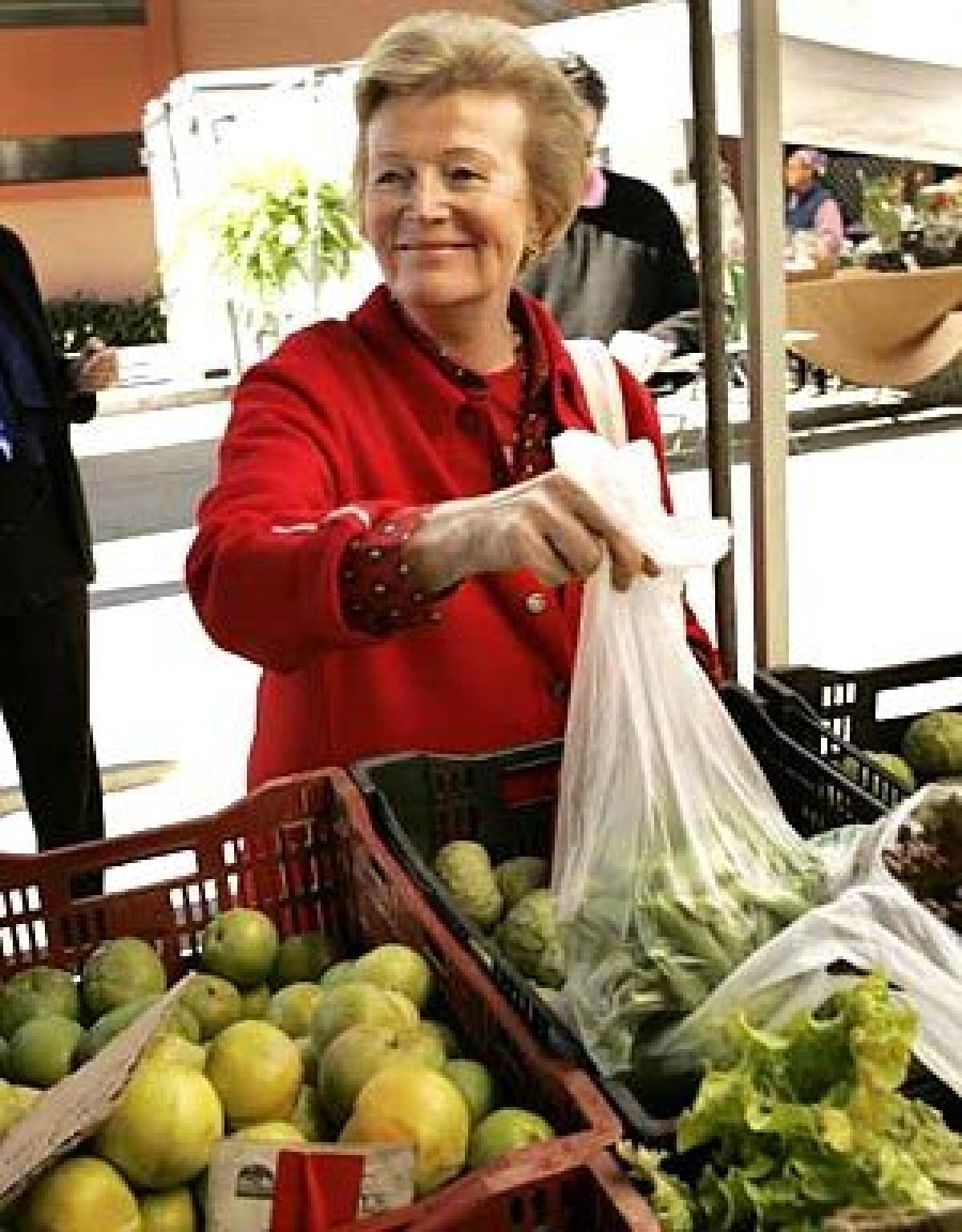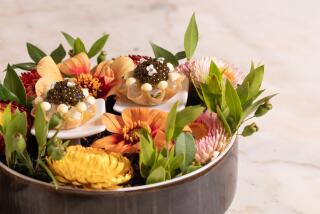Anne Willanâs movable feast hits L.A.

ANNE WILLAN is shopping at the Santa Monica Farmersâ Market when out of the blue an attractive young woman comes up to introduce herself. âI met you at a Les Dames [dâEscoffier] dinner,â she says earnestly. âI just wanted to say how glad I am that you joined our market.â
Willan, perfectly coiffed and slightly regal in a well-tailored wool suit even at this early hour, thanks her politely, then, after the woman has walked away, turns and asks with a slightly quizzical look: âThat was nice, wasnât it?â
If she seems a little taken aback, itâs certainly not because of being recognized -- Willan has been a guiding force in the cooking world for decades -- rather, it is probably the very Californian form the greeting took.
Willan has made her home in Los Angeles just since Christmas, and you get the sense that after 25 years of living in a château in the French countryside, this very proper Englishwoman may still be feeling a bit like a duck out of water in Southern California.
Though she may not have the instant name recognition of a Rachael Ray or Mario Batali, Willanâs influence on the food world has been profound. Her La Varenne cooking school in Burgundy has long been regarded as one of the finest in the world. She has a Lifetime Achievement award from the International Assn. of Culinary Professionals, is a Grande Dame of Les Dames dâEscoffier International and has been named to the Australian World Food Media Awards Hall of Fame.
Sheâs written at least a couple dozen well-received cookbooks (even she doesnât know the exact number), including two that have become culinary bibles: âLa Varenne Pratiqueâ and âFrench Regional Cooking.â Willanâs books have been published in 24 countries and translated into 18 languages. Her most recent, âThe Country Cooking of France,â came out in September.
Storybook heroine
BUT last fall, Willan and her husband, Mark Cherniavsky, in the wake of health problems he suffered, decided to leave the French countryside and join their daughter Emma Cherniavsky and her husband, Todd Schulkin, here.
Many people go through a downsizing at a certain point in their lives, but few do it quite as dramatically as Willan has. In December, she and Cherniavsky packed up their 18-bedroom, 17th century château in Burgundy and moved to a two-bedroom apartment in Marina del Rey.
Granted, thatâs only temporary quarters until they have finished remodeling their new home, a very nice Leave-It-to-Beaver-ish two-story in Santa Monica, but . . . well, their last home was the Château du FeĂż.
Itâs the latest chapter in a life that reads like something out of fiction. In fact, itâs easy to see Willan as a Jane Austen character grown up. Sheâs attractive, but not in a shiny way; sheâs smart, and sheâs strong of character.
She has a story worthy of an Austen heroine as well. A daughter of privilege, Willan turned her back on the comfortable life planned for her to follow her heart (both personally and professionally) and wound up not only living at Versailles, but also owning her own château in France.
Indeed, even a writer as spirited as Austen might have had trouble inventing this story. Raised in a wealthy family in Yorkshire, she graduated from Cambridge in 1959 with a masterâs degree in economics. She still speaks in a polished English accent that lends everything she says a note of gravitas (and that makes her dry sense of humor crackle once youâve caught on).
Encouraged by an early employer while teaching at a finishing school, she took classes at Londonâs famed Cordon Bleu cooking school. âThat changed everything,â Willan says. âOnce I did that, I never wanted to do anything else. When I found cooking, it was decided for me. I just had to do it.â
With her parentsâ begrudging support after graduating from that school she went to Paris to finish her studies, earning the coveted Grand Diplome in 1963.
On a small inheritance, she moved into an even smaller apartment and put an ad in the International Herald Tribune: âCordon Bleu cook will give lessons and cook for dinner parties.â There were six replies, she recalls, including âone from a gentleman who wanted me to cook âintimate dinner partiesâ in his suite.â She chuckles at the memory.
Versailles attic
ATTRACTIVE as that offer might have been, there was another even better. It came scrawled on heavily embossed stationery from the Château de Versailles. Willan remembers that it said, âI have Mexican cooks. I am starting to entertain at the Château de Versailles so I want my cooks to learn French cooking. Please come to see me.â
The note was from the American-born philanthropist and socialite Florence van der Kemp, who had recently married her third husband, the curator of Versailles (not satisfied with restoring that palace, the couple later went on to fix up Monetâs gardens at Giverny).
Willan started out by giving twice-a-week cooking classes and wound up living at Versailles, albeit in an attic over the servantsâ quarters.
While working for Van der Kemp, Willan cooked for the duke and duchess of Windsor, Prince Rainier and Princess Grace of Monaco and the flamboyant Countess Mapie de Toulouse-Lautrec, a cookbook author in her own right, who pointed out that Willan seemed to have thickened her luncheon boeuf Ă la mode en gelĂŠe with gelatin rather than pure veal stock. âI blushed,â Willan remembers, âbut fortunately only she and I understood the nuance of what she said.â
Another dinner party guest was Cherniavsky, a young World Bank economist. The two fell in love, and when Cherniavsky was transferred to Washington, D.C., a year later, Willan followed him, moving to New York. There, with the help of Van der Kemp, she secured a job as an editor at Gourmet magazine. A year later, she and Cherniavsky were married and she moved to Washington to become the food editor of the now-defunct Washington Star newspaper.
For the next decade, they bounced back and forth between the U.S. and France. While Cherniavsky worked for World Bank, she taught cooking and wrote -- typically for the serious-minded Willan, her fledgling effort in the cookbook world was editing Cordon Bleuâs 20-volume Grand Diplome Cooking Course encyclopedia.
In 1975 she opened La Varenne in Paris. In 1982, she and Cherniavsky bought Château du Feÿ, near the town of Joigny in Burgundy. And in 1991 they moved the school there. Her intention for La Varenne, she says, was to offer the culinary equivalent of a college education.
âI wanted [the students] to go away looking at food in a different way,â she says. âIt was a direct outcome of the habits of analysis one is taught at a good university. I wanted them to go away from a dish thinking about what the tastes had been and how the chefs had gotten them, where the ingredients had come from, what the background of the food was, what the chef had been trying to do, was it country cooking or classical cooking?â
Eventually, Willan may begin teaching here -- the remodel at the new place includes a pivoting work island that son-in-law Schulkin designed that will allow her to convert the kitchen to a classroom if she desires.
But right now, her concern is bookshelves. She and her husband are ardent collectors of many things, but particularly books. They have more than 5,000 volumes, including a second edition âLe Cuisinier Françoisâ from 1652 by François Pierre de la Varenne, her schoolâs namesake, and a 15th century incunabulum (early printed book) of dietary instructions for Latin monks. In fact, the couple are working on a book about their book collection.
Since the house had not a single bookshelf when they bought it, the first step in the renovation was installing 350 feet of them (after reinforcing the floors to support the weight). Once thatâs taken care of, Willan will figure out what to do with the coupleâs collection of more than 200 gastronomic prints -- some dating to the 17th century. When thatâs done, sheâll find room for her motherâs collection of wineglasses, the oldest of which date to the days of the Stuarts.
Food seems central to Willanâs existence. Indeed, it seems to serve as a place of refuge during this hectic transition -- a safe home base to which she can always return.
Sheâs already started to attend the Saturday Pico farmers market. And she was very impressed by the grand Santa Monica Wednesday market.
Though her old farmers market in Joigny has history (it has operated more or less continuously since Roman times), splendid poultry, a foie gras producer and a couple of wonderful cheese merchants, she says the produce in Santa Monica is much more diverse and a lot of it is better than what she could get in France.
And then thereâs that peculiarly Santa Monica community spirit her greeter exemplified.
âItâs all very idealistic, isnât it?â she says. âYou can tell that this market has really been supported by the local community and the chefs and the local government. I get a very strong feeling of a market that is looking to the future, of accomplishing something important, of showing the way.
âI must say [the market in Joigny] is going through a very bad patch at this moment. But despite this, there is no thought that the local businesses ought to support the market in any way. There is no feeling that the market is something important to Joigny, or to our lives, or to the future. Most people shop there because it is cheaper than the supermarkets.â
And those habits of analysis are still sharp. At lunch one day at Violet, the goth-modern restaurant on Pico, she likes the food but canât help keeping up a running commentary on the details of preparation (though she doesnât bat an eye when heavily mascaraed chef Jared Simons comes out to deliver a few dishes personally, looking a bit like an extra from the âRocky Horror Picture Show.â)
The potted pork rillettes are very good, she says, and itâs a shame no one serves them anymore. Still, she observes that theyâre a little under-seasoned and that the onion marmalade on top is a bit too sweet. Sheâs a little puzzled by the grilled romaine (âItâs a little like what they do with radicchio in Italy, isnât it?â). But sheâs enthusiastic about the macaroni and cheese, threaded with leeks and strips of Serrano ham.
Going native
CALIFORNIA seems inevitably to change cooks who move here, even those as stolidly French as Willan. Indeed, she says she can already see that happening.
âItâs changed me already, without my making any deliberate decisions,â she says. âIâm one who always picks up what looks best when I go to the market and that is so different here than in France. We are eating much more meat -- even beef, which we never ate in France. And much more greens and much more fruit.
âAnd weâre eating funny things like seeds and sprouts. We eat a lot of mixed salads as first courses: some nice greens and crumbled cheese and then something crunchy for the top and something crunchy can be nuts and seeds. Itâs really very nice.
âWe always thought weâd end our days in France. But I think weâll be fine. This is such a great place for food. Itâs a wonderful place to cook. The ingredients are outstanding, and there is so much going on. I do miss the cheese, though.â
More to Read
Sign up for Essential California
The most important California stories and recommendations in your inbox every morning.
You may occasionally receive promotional content from the Los Angeles Times.











